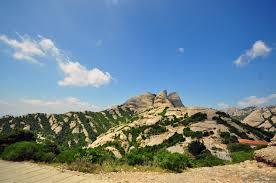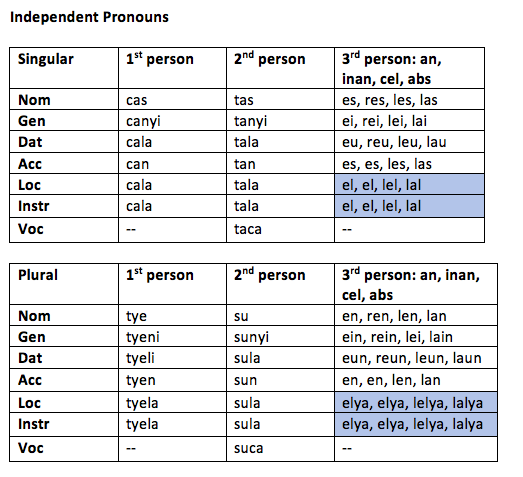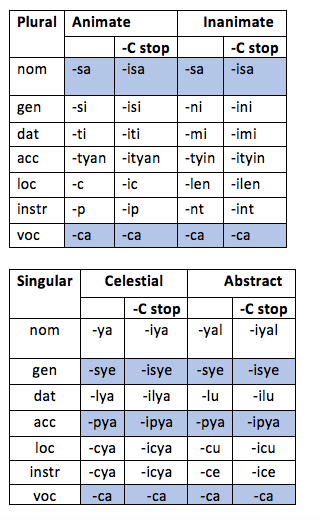Last time we looked at some ways to conjugate verbs in Ori--specifically verbs ending in -i or in alveolar sounds (-t, -d, -n, -s, -l, -r). Some examples of these:
merir ‘he/she/it dances’ (animate, inanimate)
boltimbra ‘we keep’ (boltin- + -bra)
lalta ‘they laugh’ (celestial, abstract) (lar- + -lta)
As you can see from some of the above verbs, sometimes there is variation in stem or ending, as per phonotactic constraints.
Today I want to show the 2nd and 3rd conjugations, which will wrap up all of the regular verbal classes.
The first class, as we saw, includes verbs ending in -i and in alveolars. The second class includes verbs ending in -e, -a, and velar consonants (-c and -g).
cuhe- ‘cleave’
syeg- ‘steal’
ta- ‘speak’
plec- ‘fall’
Note differences in endings in bold.
cuhe-ni ‘I cleave’
cuhe-ti ‘you cleave’
cuhe-ri ‘he/she/it cleaves’ (an, inan)
cuhe-li ‘he/she/it cleaves’ (cel, abs)
cuhe-ce ‘we cleave’
cuhe-cya ‘you all cleave’
cuhe-cyo ‘they cleave’ (an, inan)
cuhe-cyon ‘they cleave’ (cel, abs)
ta-ni ‘I speak’
ta-ti ‘you speak’
ta-ri ‘he/she/it speaks’ (an, inan)
ta-li ‘he/she/it peaks’ (cel, abs)
ta-ce ‘we speak’
ta-cya ‘you all speak
ta-cyo ‘they speak’ (an, inan)
ta-cyon ‘they speak’ (cel, abs)
syeg-i ‘I steal’
syeg-it ‘you steal’
syeg-ir ‘he/she/it steals’ (an, inan)
syeg-il ‘he/she/it steals’ (cel, abs)
syeg-e ‘we steal’
syeg-ya ‘you all steal’
syeg-yo ‘they steal’ (an, inan)
syeg-yon ‘they steal’ (cel, abs)
plec-i ‘I fall’
plec-it ‘you fall’
plec-ir ‘he/she/it falls’ (an, inan)
plec-il ‘he/she/it falls’ (cel, abs)
plec-e ‘we fall’
plec-ya ‘you all fall’
plec-yo ‘they fall’ (an, inan)
plec-yon ‘they fall’ (cel, abs)
~
The 3rd, and final regular verb conjugation includes verbs ending in -o, -u, and labial consonants (-b, -p, and -m).
pellum- ‘count’
cyep- ‘take, grab’
lyab- ‘lick’
brelo- ‘nuzzle against’
ryesu- ‘sip’
Once again, note changes in stem or ending marked in bold.
ryesu-m ‘I sip
ryesu-tu ‘you sip
ryesu-ru ‘he/she/it sips’ (an, inan)
ryesu-lu ‘he/she/it sips’ (cel, abs)
ryesu-bru ‘we sip’
ryesu-ru ‘you all sip
ryesu-bu ‘they sip’ (an, inan)
ryesu-ltu ‘they sip’ (cel, abs)
(Verbs ending in -o, such as brelo- ‘nuzzle against’ conjugate exactly the same way as those verbs in -u.)
pellum-u ‘I count’
pellun-tu ‘you count’
pellur-ru ‘he/she/it counts’ (an, inan)
pellul-lu ‘he/she/it counts’ (cel, abs)
pellum-bru ‘we count’
pellum-ru ‘you all count’
pellum-bu ‘they count’ (an, inan)
pellul–tu ‘they count’ (cel, abs)
cyep-u ‘I take’
cyep-pu ‘you take’
cyep-ru ‘he/she/it takes’ (an, inan)
cyep-lu ‘he/she/it takes’ (cel, abs)
cyep-pru ‘we take’
cyep-ru ‘you all take’
cyeb-bu ‘they take’ (an, inan)
cyel-tu ‘they take’ (cel, abs)
lyab-u ‘I lick’
lyab-du ‘you lick’
lyab-ru ‘he/she/it licks’ (an, inan)
lyab-lu ‘he/she/it licks’ (cel, abs)
lyab-bru ‘we lick’
lyab-ru ‘you all lick’
lyab-bu ‘they lick’ (an, inan)
lyal-tu ‘they lick’ (cel, abs)
~*~*~*~*~*~
Ok, so that is it for present conjugation of regular verbs. You may wonder about other tenses. Ori is pretty light on the morphological tense. It uses some different particles that follow the verb to indicate various tenses and aspects, though.
cyan — past perfect
Ex.: Es lyab-u cyan
3sg.inan.acc lick-1sg pst.prf
‘I licked it’
Tun-pori-tyan cyep-pru cyan
def.art.an.pl sheep-acc.an.pl-1pl pst.prf
‘We took the sheep (pl)’
lyes — past imperfective/habitual
This particle also indicates past tense, but the aspect is different. Instead of perfect, like cyan, lyes indicates an incompleted action in the past or a habitual action in the past (that happened many times).
Ex.: Gotebinur-ipya ta-ri lyes
Gotevian-acc.abs.sg speak-3sg.an pst.hab
‘She used to speak Gotevian’
bil — modal
This modal particle indicates a speaker;s uncertainty that the statement is true.
Ex.: En cyep-ru bil.
3pl.inan.acc take-3sg.an mod
‘He might be taking them’ / ‘Maybe he is taking them’
The modal bil particle can also be combined with the other particles:
Ex.: En cyep-ru cyan bil.
3pl.inan.acc take-3sg.an pst.prf mod
‘He might have taken them’
Ok, that is a lot of info for one post, so I will continue later! Question if anyone cares–do you want to see more linguistic info on Ori, or should I break it up with some cultural info? Shall I stick to Ori for a while or visit some other places/people/languages?
Mintaka


















